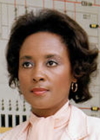Annie Jean Easley

April 23, 1933 - June 25, 2011
Contributed by Nicholas Li, Phillips Exeter Academy, Exeter NH
Annie Jean Easley was a pioneer in the field of space exploration, known for her contributions to the space program despite racial biases. Born on April 23, 1933 in Birmingham, Alabama, Easley matriculated at Cleveland State University where she graduated with a Bachelor of Science in mathematics in 1977. Her career was one of many firsts for African Americans in the United States. She was one of few African Americans in the field of engineering, and in the 1950s and 1960s she was one of extremely few women engineers working at the NACA Lewis Flight Propulsion Laboratory which then became known as NASA’s Lewis Research Center (now Glenn Research Center).
At NASA, Easley worked and developed code for the Centaur rocket stage, programming the engine’s onboard flight computer. Her mathematical prowess and code prowess aided in the development of the powerful upper stage of the Atlas and Centaur rocket. In a career spanning more than fifty years, Easley made foundational contributions to flight computers, numerical analysis and space exploration. At NASA she was one of only three black women in an engineering division out of 2500 professionals.
Easley lived in a society in which there was a lack of space exploration and people of color were excluded in the field of science; she experienced racism in both her personal life and at work. However, she never let this stop her from pushing forward. During her time at NACA she regularly encountered racial discrimination. She would be routinely excluded from white male team members who came to the labs. In an interview responding to her absence from NASA’s promotional photos, she said "I'm out here to do a job and I knew I had the ability to do it, and that's where my focus was, on getting the job done. I was not intentionally trying to be a pioneer."[1]
Despite discrimination, Easley made contributions to NASA and space exploration. "My head is not in the sand. But my thing is, if I can't work with you, I will work around you. I was not about to be so discouraged that I'd walk away. That may be a solution for some people, but it's not mine."[1] In 2015, Easley was posthumously placed into the Glenn Hall of Fame.
References
- "Annie J. Easley Oral History." NASA. Accessed April 1, 2022. https://historycollection.jsc.nasa.gov/JSCHistoryPortal/history/oral_histories/NASA_HQ/Herstory/EasleyAJ/EasleyAJ_8-21-01.htm.
- Heidman, Kelly. "Annie Easley, Computer Scientist." NASA. NASA, September 21, 2015. https://www.nasa.gov/feature/annie-easley-computer-scientist/.
- Samorodnitsky, Dan. "Meet Annie Easley, the Barrier-Breaking Mathematician Who Helped US Explore the Solar System." Massive Science, November 26, 2018. https://massivesci.com/articles/annie-easley-facts-stem-mathematician-nasa-scientist-discrimination/.
- Thomas, Kindra. "Annie Easley, Computer Scientist and Mathematician." NASA. NASA, March 16, 2017. https://www.nasa.gov/image-feature/annie-easley-computer-scientist-and-mathematician/.
Other Resources
- Annie Easley, Wikipedia
- Annie J. Easley, encyclopedia.com
